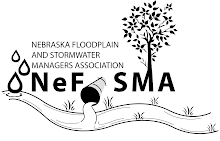Stormwater Management Practices: Some Cost Comparisons - Lowell Johnson, City Administrator, Wayne, NE; Katie Underwood, P.E., Olsson Associates, David P. Shelton, UNL Extension Agricultural Engineer
Session participants will learn about:
· Selected green infrastructure practices for stormwater management
· Cost comparisons of green and gray infrastructure stormwater management practices for projects in Wayne, NE and LID practices in Overland Park, KS
· University of Nebraska stormwater management programming and information available to municipalities and others
Traditional approaches treat stormwater as a problem to be conveyed away as rapidly as possible with curbs, gutters, storm drains, and similar practices. The new paradigm views stormwater as a resource to be retained and used on-site or allowed to infiltrate. Green infrastructure such as rain gardens, bioswales, rain barrels, eco roofs, and others manage stormwater on a small scale more naturally, conserve water, and improve water quality by retaining runoff that may contain multiple contaminants. On a larger scale, low impact development (LID) helps protect aquatic resources, water quality, and the natural hydrology of a watershed as development takes place. Both green infrastructure and LID practices are based on the premise that nature knows best how to manage water and stormwater runoff. These practices can often be used to help meet USEPA MS4 requirements. This proposed presentation will highlight selected green infrastructure and LID practices for managing stormwater.
Municipalities have generally been somewhat slow to adopt green infrastructure and/or LID practices for a variety of reasons. One of these is lack of familiarity with the practices, while another is lack of cost comparisons between these practices and the much more familiar gray infrastructure and conventional development practices. Although not an MS4 municipality, Wayne, NE has installed several green infrastructure practices within the past two to three years in new residential and industrial developments. This presentation will summarize cost comparisons for the green infrastructure and traditional gray infrastructure in these developments. As an example, in one industrial development, 2,000 linear feet of bio-swale was installed at a cost of $48,000 as compared to the original design of 2,000 linear feet of concrete pipe and two drop structures costing a total of $115,000.
Olsson Associates conducted a cost analysis for implementation of LID and conservation development Best Management Practices for sites in Overland Park, KS, and found costs to be comparable with conventional development practices. Summary data for single-family, multi-family, and commercial/office sites evaluated will be presented.
In 2006, the University of Nebraska formed a Stormwater and Green Space Work Group, with an initial focus of addressing the needs of Phase II communities across Nebraska relative to stormwater management regulations. Publication and other educational material development was a primary emphasis of this group. Further supporting stormwater management programming, UNL received a USDA National Institute of Food and Agriculture grant in 2009. Components of this grant include extension education, research on existing rain garden hydrology, and curriculum development for Landscape Architecture college courses. This presentation will highlight educational and other programming offered by UNL Extension to help municipalities and others address stormwater management issues.


No comments:
Post a Comment